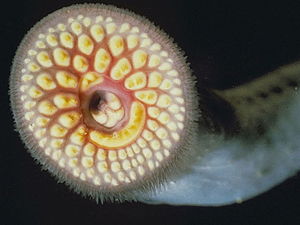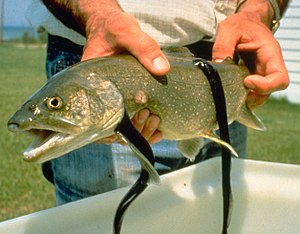
The sea lamprey (Petromyzon marinus) is one of four lamprey species found in the Lake Champlain Basin out of 31 species found world-wide. According to some, the sea lamprey species is proving to be a problematic presence in Lake Champlain.
What is a Lamprey?
Lampreys are eel-shaped fish with a skeleton made of cartilage, with smooth, scaleless skin and two dorsal fins on their backs.
“The sea lamprey is parasitic; it feeds on other fish, using a suction disk mouth filled with small sharp, rasping teeth and a file-like tongue. These are used by the sea lamprey to attach to a fish, puncture its skin, and drain its body fluids.” (NYDEC)

Sea lamprey have a cylical life cycle:
- “The first four years of their life are spent as ammocoetes – a blind worm-like larval stage – in the soft bottom and banks of waters that flow into Lake Champlain.” (NYDEC)
- Then they transform into the parasitic adult stage and enter the lake to feed.
- “After twelve to twenty months in the lake the adults migrate back into the streams flowing into the lake to spawn”–tens of thousands of eggs from a single pair! (NYDEC)
- Soon after spawning, the adults die.
Negative Impacts of Lake Champlain Lampreys
Lake Champlain lampreys have become a serious problem to the other fish populations in the lake.
“Studies on the Great Lakes show a 40 to 60 percent mortality rate for fish attacked by sea lamprey. Other studies have found that a single sea lamprey can kill 40 or more pounds of fish during its life. Even when fish survive the attacks, the fish populations will decline as the fish expend more energy on healing than on producing eggs and mating.” (NYDEC)

This reduced number of fish has given a harsh blow to the fishing industry in the Lake Champlain region. With less and less fish for anglers to catch, fewer fishing tourists are visiting our lake. Some are even spreading the word that this is not the place to vacation if you want to fish!
This is having an overreaching effect on those “whose livelihood is directly or indirectly supported by the fishing and tourist industry” (NYDEC).
Ways to Control Lampreys
Lake Champlain lamprey control programs are run jointly by the US Fish and Wildlife Service, the VT Fish and Wildlife Department, and the NY State Department of Environmental Conservation (Lake Champlain Basin Program).
A “long-term control program began in 2002 following the evaluation of an eight-year experimental program. Thirteen tributaries were treated with the chemical lampricides 3-trifluoromethyl-4-nitrophenol (TFM) and Bayer 73 was used on five tributary deltas.” (Lake Champlain Basin Program)
These chemicals have proven to be non-harmful in the waters they have been used in. After years of study, “fisheries managers have concluded that the lampricides have little or no known permanent effect on populations of non-target species present in the treatment areas.” (NYDEC)
Other non-chemical alternative sea lamprey controls that have been tested include:
- Nest raking/disruption
- Sterile male release
- Trapping
- Installation of physical controls and low head barrier dams
Are Lake Champlain Lamprey Controls Working?
These methods combined have shown a positive effect. The negative effects of the Lake Champlain lampreys are decreasing, and the fish population in the lake is being restored. More work must be done to ensure this continues.
“Results from the program showed that the number of sea lamprey wounds found on lake trout decreased, as shown on [this] Sea Lamprey Wounds graphic.
In addition, the average number of sea lamprey wounds on landlocked Atlantic salmon decreased, and the number of salmon and lake trout caught increased.” (Lake Champlain Basin Program)
Total eradication of the Lake Champlain lamprey population is not the goal of the program, but rather to reduce the impacts of sea lampreys on the lake’s fishery and to restore balance to the ecosystem (NYDEC).
Related articles




Are they edible by humans ? Certainly they used to be in England . I enjoy eel so perhaps there is a market here
I’ve never heard of anyone locally (Lake Champlain area) eating lamprey eels, but I’ve heard that solution proposed — usually tongue in cheek — over the years. Pretty creepy looking critters, but so are sea urchins and squid, but BOTH are delicious. How about proposing a recipe to move this brainstorm forward!?!? 🙂